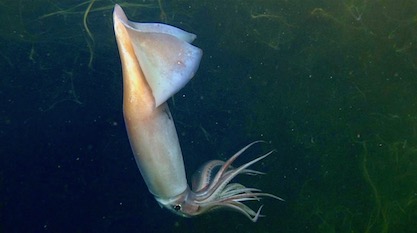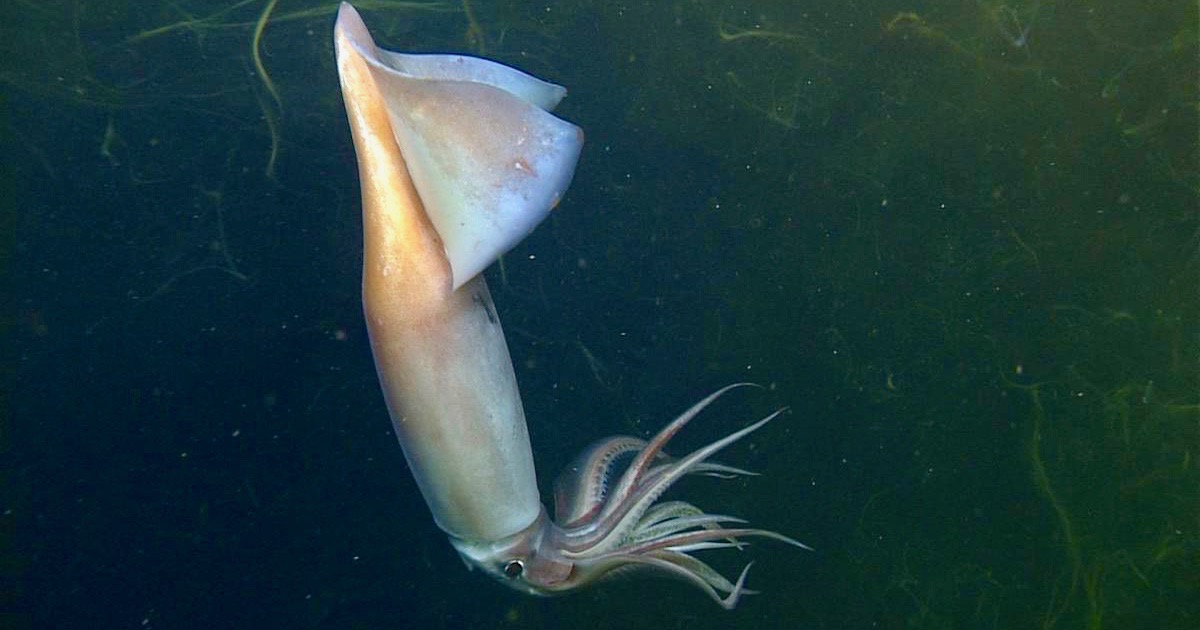 Evolution
Evolution
 Intelligent Design
Intelligent Design
Squid’s Got Talent — Super-Powers Astonish Scientists


They swim. They shine. They camouflage themselves. The humble squid astonishes scientists with its super-powers. Are these marine champions really the products of random mutations and natural selection? Just saying so is not convincing when you look at the facts.
Ranging in size from fingerlings to sea monsters, squid look like visitors from an alien planet. So do the other main groups within cephalopods (“head-foot”), the octopuses and cuttlefish. Those cousins are no less extraordinary, but recent news and research showcase the talent of these amazing creatures. (Note: “squid” can be both singular and plural; as with fish, it’s “one squid, two squid, red squid, blue squid.” But “squids” is acceptable, especially if talking about different species. The size range of squids is enormous, from 10 centimeters to 24 meters!)
Communicating with Light
A researcher used a remotely operated vehicle to peer deep into the blackness of Monterey Submarine Canyon. He wished to study a strange visual code of the Humboldt squid, Dosidicus gigas, reports Stanford News Service.
In the frigid waters 1,500 feet below the surface of the Pacific Ocean, hundreds of human-sized Humboldt squid feed on a patch of finger-length lantern fish. Zipping past each other, the predators move with exceptional precision, never colliding or competing for prey.
How do they establish such order in the near-darkness of the ocean’s twilight zone? [Emphasis added.]
Benjamin Burford, a grad student and lead author of a paper with a ROV (remotely-operated vehicle) specialist from the Monterey Bay Aquarium, found that this difficult-to-observe species has light-producing organs in its muscles. These organs allow the squid to signal each other with light. Like a Kindle e-reader, the animal “can create a backlight for shifting pigmentation patterns on their skin.” And thus, a flashing signal is born.
“Many squid live in fairly shallow water and don’t have these light-producing organs, so it’s possible this is a key evolutionary innovation for being able to inhabit the open ocean,” said Benjamin Burford, a graduate student in biology in the School of Humanities and Sciences at Stanford and lead author of the paper. “Maybe they need this ability to glow and display these pigmentation patterns to facilitate group behaviors in order to survive out there.”
Evolution is sure to provide whatever innovation is needed, don’t you think? It exists; therefore, it evolved.
Little to Say About Evolution
The actual paper in PNAS, “Bioluminescent backlighting illuminates the complex visual signals of a social squid in the deep sea,” has very little to say about natural selection, other than noting some possible “selective pressures” and concluding, “The evolution of complex visual signals in these squids may therefore have been driven by content- and efficacy-based selection.”
More interesting than “the evolution of” the squid is the nature of the light-producing organs themselves. They look positively designed:
Numerous small subcutaneous (s.c.) photophores (bioluminescent organs) embedded throughout the muscle tissue make the entire body glow, thereby backlighting the pigmentation patterns. Equipped with a mechanism by which complex information can be rapidly relayed through a visual pathway under low-light conditions, our data suggest that the visual signals displayed by D. gigas could share design features with advanced forms of animal communication.
A single squid may have hundreds of these organs. The photophores are oriented not to shine outward but to illuminate pigment patterns on the skin, making the whole creature cast its pattern to the others. Compare this to how bats communicate in the dark with sound clicks, each distinct enough to avoid collisions. Nature comments on the light show, saying that the squid flash each other when approaching their own kind.
But when squids pursued prey, they dimmed themselves. Then, just before striking, they suddenly flashed a splotchy pattern by lighting up organs beneath intermittently pigmented parts of their body.
It’s the last freaky thing the prey would ever see under the sea.
The “design features” of the Humboldt squid appear unique to this species. A Hawaiian species that lives in shallow water also glows, but doesn’t combine its bioluminescence with this “complex chromatophore patterning.” The judges for an imaginary Ocean’s Got Talent program would surely be impressed with this species and its “synchronized swimming with light” show.
Master Gene Editors
Meanwhile, over on the East Coast, researchers at the University of Chicago’s Marine Biology Laboratory at Woods Hole, Massachusetts, found another talent in the amazing squid.
Revealing yet another super-power in the skillful squid, scientists have discovered that squid massively edit their own genetic instructions not only within the nucleus of their neurons, but also within the axon — the long, slender neural projections that transmit electrical impulses to other neurons. This is the first time that edits to genetic information have been observed outside of the nucleus of an animal cell.
The implications of this discovery give bad karma to dogma.
The discovery provides another jolt to the central dogma of molecular biology, which states that genetic information is passed faithfully from DNA to messenger RNA to the synthesis of proteins. In 2015, Rosenthal and colleagues discovered that squid “edit” their messenger RNA instructions to an extraordinary degree – orders of magnitude more than humans do — allowing them to fine-tune the type of proteins that will be produced in the nervous system.
“But we thought all the RNA editing happened in in the nucleus, and then the modified messenger RNAs are exported out to the cell,” says Rosenthal, senior author on the present study. “Now we are showing that squid can modify the RNAs out in the periphery of the cell. That means, theoretically, they can modify protein function to meet the localized demands of the cell. That gives them a lot of latitude to tailor the genetic information, as needed.” The team also showed that messenger RNAs are edited in the nerve cell’s axon at much higher rates than in the nucleus.
Revelations to Come
This discovery hints at more revelations to come. What signals the peripheral RNAs to change? What pathway decides, and what environmental clues trigger the change? How much latitude for tailoring the transcripts is there? The team knows there is much more to learn, and perhaps the gene editing tricks of the squid will help humans with disabilities someday.
Previously, Rosenthal and colleagues showed that octopus and cuttlefish also rely heavily on mRNA editing to diversify the proteins they can produce in the nervous system. Together with squid, these animals are known for strikingly sophisticated behaviors, relative to other invertebrates.
The vertebrate-like camera eyes of cephalopods are additional wonders to challenge our colleagues who trust in chance to create “design features,” but no need for overkill.
Want to know more about squid? Read about the giant squid here at Evolution News. See also Cornelius Hunter’s post about massive RNA editing in the octopus. Jonathan Wells discussed the design of cephalopod eyes here. And Walter Myers added to the discussion about “bad design” arguments comparing human eyes and cephalopod eyes. Finally, Doug Axe called attention to another skill in cuttlefish that challenges evolution.
Photo credit: Humboldt squid (Dosidicus gigas), © 2010 MBARI via EurekAlert!
